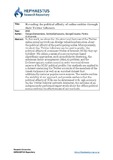| dc.contributor.author | Stamatelatos, Giorgos | |
| dc.contributor.author | Gyftopoulos, Sotirios | |
| dc.contributor.author | Drosatos, George | |
| dc.contributor.author | Efraimidis, Pavlos S. | |
| dc.date.accessioned | 2021-03-08T10:34:04Z | |
| dc.date.available | 2021-03-08T10:34:04Z | |
| dc.date.issued | 2020-03 | |
| dc.identifier.issn | 102172 | |
| dc.identifier.uri | http://hdl.handle.net/11728/11756 | |
| dc.description.abstract | In this work, we show that the structural features of the Twitter online social network can divulge valuable information about the political affinity of the participating nodes. More precisely, we show that Twitter followers can be used to predict the political affinity of prominent Nodes of Interest (NOIs) they opt to follow. We utilize a series of purely structure-based algorithmic approaches, such as modularity clustering, the minimum linear arrangement (MinLA) problem and the DeGroot opinion update model in order to reveal diverse aspects of the NOIs’ political profile. Our methods are applied to a dataset containing the Twitter accounts of the members of the Greek Parliament as well as an enriched dataset that additionally contains popular news sources. The results confirm the viability of our approach and provide evidence that the political affinity of NOIs can be determined with high accuracy via the Twitter follower network. Moreover, the outcome of an independently performed expert study about the offline political scene confirms the effectiveness of our methods. | en_UK |
| dc.language.iso | en | en_UK |
| dc.publisher | Elsevier Ltd. | en_UK |
| dc.relation.ispartofseries | vol. 57;issue 2 | |
| dc.rights | © 2019 Elsevier Ltd. All rights reserved. | en_UK |
| dc.rights.uri | http://creativecommons.org/licenses/by-nc-nd/4.0/ | en_UK |
| dc.subject | Social network analysis | en_UK |
| dc.subject | Twitter followers | en_UK |
| dc.subject | News media | en_UK |
| dc.subject | Political affinity | en_UK |
| dc.title | Revealing the political affinity of online entities through their Twitter followers | en_UK |
| dc.type | Article | en_UK |
| dc.doi | https://doi.org/10.1016/j.ipm.2019.102172 | en_UK |


